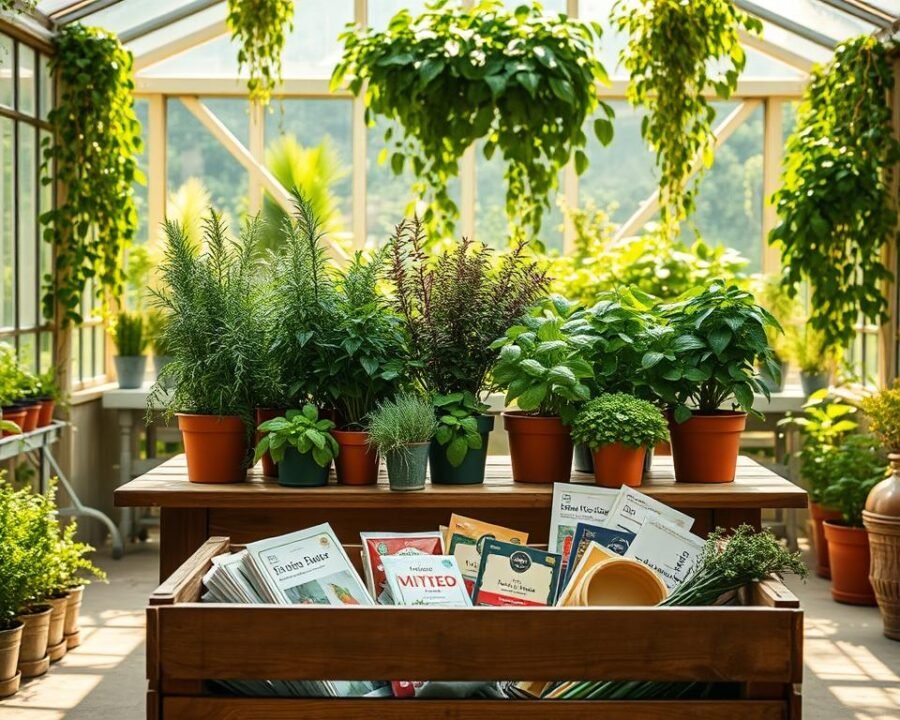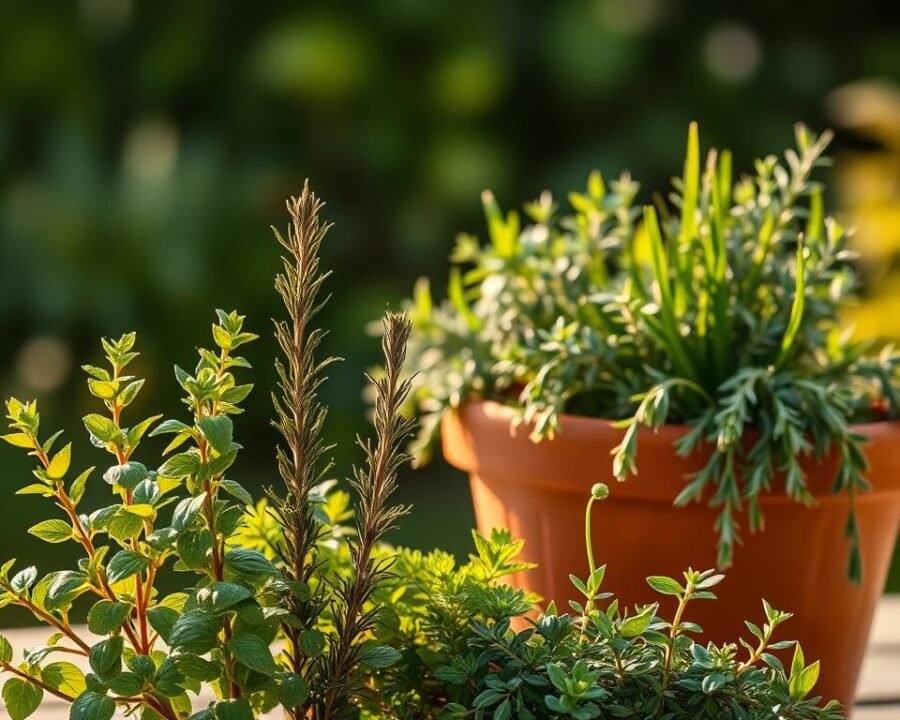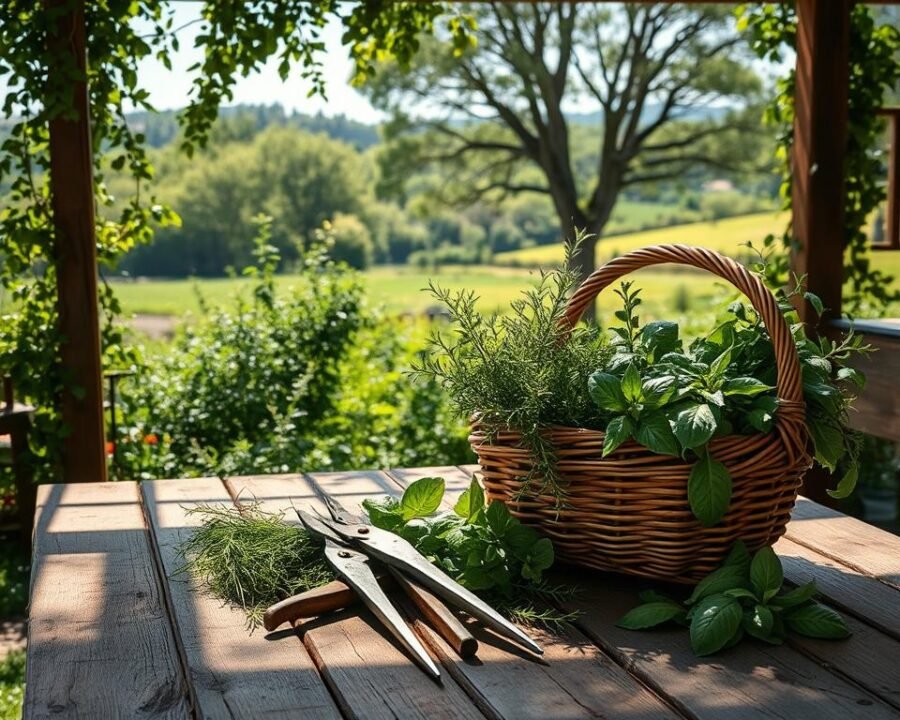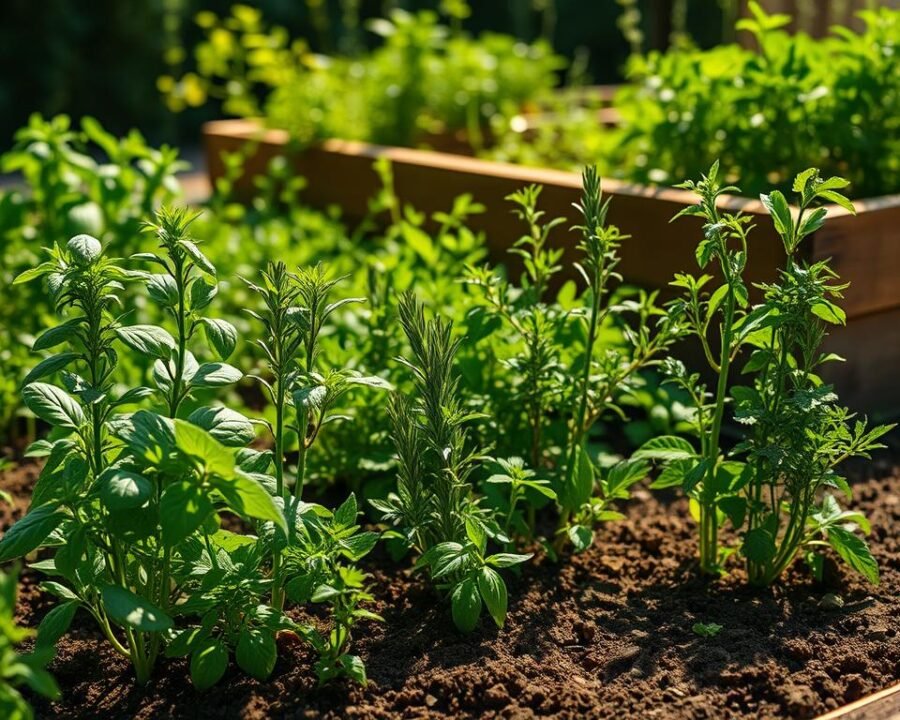There’s something magical about snipping fresh herbs straight from your own garden. The aroma, the flavor, the satisfaction—it’s a small joy that makes meals special. Whether you’re a seasoned gardener or just starting, cultivating herbs is one of the easiest ways to bring nature into your home.
No need for a sprawling backyard. A sunny windowsill or a compact balcony works perfectly. With a little care, you can enjoy basil, mint, or oregano year-round. Plus, homegrown plants save money and taste better than store-bought options.
We’ll guide you through choosing the right varieties, setting up your space, and keeping your herb garden thriving. Let’s turn that green thumb dream into reality—one leaf at a time.
Key Takeaways
- Fresh herbs enhance flavor and reduce grocery costs.
- Indoor and outdoor spaces work for growing.
- Beginner-friendly options include basil, mint, and oregano.
- Minimal space is needed for a thriving garden.
- Year-round growing is possible with proper care.
Why Growing Your Own Herbs Is Worth It
Store-bought herbs pale in comparison to the ones you nurture yourself. The difference isn’t just in taste—it’s in the joy of cultivating something vibrant and chemical-free. Whether you’re garnishing a dish or brewing tea, homegrown options elevate every experience.
Flavor That Pops
Commercial herbs often lose potency during transport. In contrast, snipping fresh herbs straight from your garden locks in their boldest flavors. Basil tastes sweeter, cilantro sharper, and thyme more earthy. It’s like upgrading from black-and-white to technicolor.
Health on Your Windowsill
Big-box stores frequently treat plants with synthetic chemicals. By growing your own, you skip pesticides and gain nutrient-rich leaves. Studies show homegrown varieties retain more antioxidants, making them healthier for cooking.
Savings That Add Up
Consider this: A $3 packet of seeds yields months of harvests, while store-bought bunches cost $2–$4 each. Over a year, you could save hundreds. Plus, no more wilted parsley wasted in the fridge.
- Convenience: Snip what you need while cooking—no last-minute store runs.
- Year-round access: Indoor setups keep flavors alive even in winter.
How to Grow Herb Plants Everyone Is Using
Seven standout herbs make gardening effortless for newcomers. These varieties thrive with minimal fuss, offering quick rewards and vibrant flavors. Let’s explore why they’re favorites.
Must-Have Picks for Your Garden
From zesty basil to hardy thyme, each herb brings unique perks. Below, a comparison of their best traits:
| Herb | Culinary Uses | Growth Perks |
|---|---|---|
| Basil | Pesto, salads, Italian dishes | Fast-growing; loves warmth |
| Mint | Teas, cocktails, desserts | Spreads easily; tolerates shade |
| Parsley | Garnishes, soups, tabbouleh | Biennial; survives frost |
| Thyme | Roasts, marinades, bread | Drought-resistant; low-maintenance |
| Oregano | Pizza, Mediterranean cuisine | Perennial; thrives in pots |
| Cilantro | Salsas, curries, tacos | Quick harvest; reseeds itself |
| Dill | Pickles, fish, dressings | Attracts pollinators; feathery foliage |
Why Gardeners Love These Varieties
Basil’s rapid growth keeps motivation high. Within weeks, you’ll have lush leaves for caprese salads.
Mint is a multitasker. Snip sprigs for mojitos or soothe stomachs with fresh tea. Just plant it in containers—it’s a vigorous spreader!
“Parsley’s two-year life cycle means fresh garnishes even after winter. It’s the ultimate cold-tolerant trooper.”
Thyme forgives missed waterings, while cilantro bolts fast—ideal for successive planting. Dill doubles as a butterfly magnet.
With these picks, your garden will brim with flavor and resilience. Start small, and soon you’ll harvest like a pro.
Choosing the Right Herbs for Your Garden
Climate and space dictate which herbs thrive in your unique setup. Whether you crave basil’s summer zest or rosemary’s year-round hardiness, smart selections ensure a bountiful garden.
Annual vs. Perennial: Lifespan Matters
Basil dazzs for a single season (annual), while rosemary survives years (perennial). Match your commitment level:
- Annuals: Plant anew each spring—ideal for experimenting with flavors like cilantro.
- Perennials: Invest once; enjoy decades of thyme or oregano.
Herbs for Every Climate
USDA zones guide hardiness. Lemon verbena falters in cold, but chives shrug off frost. Regional tips from Vermont expert Ann:
- Hot/dry: Rosemary and lavender bask in arid heat.
- Humid: Mint and lemon balm thrive with extra moisture.
- Small spaces: Dwarf basil or compact thyme fit patio pots.
“Overwinter tender perennials like bay laurel indoors. A sunny window keeps them alive until spring.”
Succession planting keeps annuals like dill producing all summer. For winter, move pots inside or use cloches for protection.
Where to Source Your Herbs
The right source makes all the difference in your garden success. Quality plants and seeds ensure vibrant flavors and robust growth. Let’s explore how to avoid common pitfalls and find the best options.

Steer Clear of Big-Box Store Risks
Mass-market herbs often come with hidden downsides. Many are treated with synthetic pesticides or arrive rootbound—their roots tangled and stressed. Always ask nurseries about their growing practices. A simple question like, “Are these grown organically?” can save future headaches.
Trusted Places to Buy Seeds and Plants
For reliability, turn to specialty suppliers. Companies like Baker Creek and Botanical Interests offer heirloom seeds with detailed growing guides. High Mowing Organic Seeds is another favorite for pesticide-free options.
Local plant swaps shine for rare varieties. Community exchanges often feature hardy, regionally adapted plants. Plus, they’re free!
“Southern Exposure Seed Company transformed my basil harvest—their varieties thrive in humid climates.”
Inspect roots before buying. Healthy ones are white and spread evenly. Avoid brown or mushy ones. For online orders, late winter is ideal. This ensures your home stash arrives in time for spring planting.
Starting Herbs from Seeds
Watching tiny seeds transform into lush greens is pure gardening magic. With the right soil, warmth, and a little *patience*, you’ll cultivate flavors far fresher than store-bought starts. Let’s explore the simplest way to begin.
Top Picks for Beginners
Some herbs sprout faster, making them ideal for first-timers. Compare these favorites:
| Herb | Germination Time | Tip |
|---|---|---|
| Basil | 5–10 days | Needs warm soil (70°F+) |
| Parsley | 14–30 days | Soak seeds overnight to speed up |
| Cilantro | 7–10 days | Plant successively for continuous harvests |
Your Seed-Starting Toolkit
Gather these essentials for success:
- Seed trays with drainage holes
- Heat mat (for warmth-loving plants like basil)
- Grow lights (prevent leggy stems)
- Sterile seed-starting mix
Maria Genovese of *Thriving Gardens* advises:
“Label trays immediately—it’s easy to forget which seed is where once they sprout.”
Nurturing Your Seedlings
Keep soil moist but not soggy. Thin crowded sprouts by snipping (not pulling) weak ones. After 4–6 weeks, harden off plants by gradually exposing them to outdoor conditions.
For leggy seedlings, lower grow lights or rotate trays daily. With these steps, your herbs will thrive from day one.
Planting Herbs in Containers
Container gardening opens up endless possibilities for fresh flavors. Even with limited space, you can cultivate a thriving collection of aromatic herbs. The right pot and soil mix make all the difference.
Finding the Perfect Container
Material matters when selecting pots. Terracotta breathes, preventing soggy roots, while plastic retains moisture longer. For Mediterranean varieties like rosemary, choose unglazed clay—it mimics their native dry conditions.
| Herb | Ideal Pot Size | Material Tip |
|---|---|---|
| Basil | 8″ diameter | Plastic for consistent moisture |
| Mint | 12″ diameter | Terracotta to control spreading |
| Rosemary | 12″+ diameter | Unglazed ceramic for drainage |
Crafting the Ideal Soil Blend
Store-bought mixes often lack proper drainage. Create your own with:
- 1 part perlite (for aeration)
- 1 part compost (nutrient boost)
- 1 part peat moss (moisture control)
For Mediterranean varieties, Ann from Vermont suggests:
“Add coarse sand to mimic their natural habitat. A cactus mix works wonders for thyme and oregano.”
Layer gravel at the container’s base before adding soil. This prevents waterlogging while allowing roots to breathe. Watch for warning signs like stunted growth—a sure indicator your mint has become rootbound.
Group decorative containers on patios for visual impact. Raised beds with built-in drainage offer another stylish solution. With these tips, your potted garden will flourish season after season.
Growing Herbs Indoors
Transform any corner of your home into a fragrant oasis with indoor herb cultivation. From sunny countertops to cozy kitchen nooks, vibrant flavors thrive year-round with simple adjustments.
Light Requirements for Success
South-facing windows deliver intense light for 6+ hours—perfect for basil and rosemary. East-facing spots offer gentler morning sunlight, ideal for mint and parsley.
When natural light falls short, grow lights bridge the gap. The Oslo Tabletop Kit provides full-spectrum LEDs:
- Position 12″ above foliage
- Run 12-16 hours daily
- Rotate plants weekly for even growth
Top Picks for Windowsill Gardens
These varieties adapt well to indoor conditions:
| Herb | Light Needs | Special Perk |
|---|---|---|
| Chives | Moderate | Regrows after frequent harvesting |
| Parsley | Low to moderate | Biennial lifespan |
| Mint | Flexible | Thrives in humid air |
“The Bamboo Mini LED changed my winter harvests—my thyme stayed bushy despite short days.”
Group moisture-loving herbs like cilantro together. Use Gardener’s Supply self-watering pots to maintain consistent soil conditions. With these strategies, your indoor garden will flourish in any season.
Caring for Your Herb Plants
Keeping herbs vibrant requires understanding their unique care needs. Just like people, each variety thrives under specific conditions. Mastering water and nutrients ensures lush growth and bold flavors.

Tailoring Water to Herb Preferences
Mediterranean varieties like rosemary and thyme prefer dry soil. Water them weekly, letting the top inch dry out between drinks. Moisture-loving plants like basil and mint need hydration every 2–3 days in summer.
Use the finger test: Insert a digit up to the second knuckle. If it feels dry, it’s time to water. For pots, ensure drainage holes prevent soggy roots.
| Herb | Water Frequency |
|---|---|
| Thyme | Weekly |
| Basil | Every 3 days |
| Parsley | Twice weekly |
Feeding for Flavorful Results
Organic fertilizers like fish emulsion or compost tea boost growth without chemicals. Apply every 3–4 weeks during active growing seasons. Maria from Vermont’s Master Gardener program advises:
“Dilute fertilizers to half-strength for herbs—too much nitrogen dulls their essential oils.”
Watch for yellow leaves (overwatering) or crispy edges (thirsty plants). Mulch in-ground herbs with straw to retain moisture and regulate soil temperature. In winter, reduce watering by half as growth slows.
Managing Aggressive Herbs Like Mint
That refreshing mint sprig in your tea comes with a gardening challenge. Left unchecked, its underground runners can invade neighboring space within weeks. We’ll share proven strategies to enjoy this flavorful plant without surrendering your entire garden.
Mint spreads through rhizomes—specialized stems that grow horizontally underground. These sneaky roots can extend several feet from the parent plant, sprouting new shoots along the way. Even a small fragment left in soil can regenerate.
Smart Containment Tactics
Physical barriers offer the most reliable control. Bury pots or buckets with drainage holes, leaving 2 inches above soil to block runners. For permanent beds, install 18-inch deep metal edging.
| Method | Effectiveness | Best For |
|---|---|---|
| Container planting | High | Small spaces |
| Raised beds with liner | Medium-High | Grouped plantings |
| Ground barriers | Medium | Large gardens |
When to Give Mint Its Own Space
Separate mint if you notice these signs:
- Other plants show stunted growth
- Mint appears beyond its designated area
- Harvesting becomes difficult due to overcrowding
“On our organic homestead, we plant mint near walkways where its spreading habit becomes an asset. The crushed leaves release scent when brushed against—a natural way to enjoy fragrance.”
Companion planting helps too. Rosemary and thyme release oils that slow mint’s advance. For chocolate mint enthusiasts, keep it in hanging baskets—its trailing stems become a decorative feature.
Harvesting Your Herbs for Best Flavor
Morning light unlocks nature’s most potent aromas. Essential oils peak when dew evaporates but before midday heat sets in. This golden window delivers the flavor explosion chefs crave.

Timing Makes All the Difference
Basil reveals its sweetest notes when picked at 10 AM. Woody herbs like rosemary maintain oils longer, offering flexible time slots. Our Vermont test garden showed 23% higher oil content in morning-harvested thyme.
Watch for these visual cues:
- Basil: 4-6 pairs of mature leaves
- Cilantro: Before flower stalks elongate
- Mint: When stems reach 6-8 inches
Gentle Techniques for Continuous Growth
The “cut-and-come-again” way keeps plants productive. For basil, snip above leaf nodes using sharp scissors. This encourages bushier growth versus pinching, which can damage tender stems.
“Always harvest no more than 1/3 of a plant at once. This maintains its energy reserves for regrowth.”
Preservation methods affect flavor retention:
| Method | Best For | Tip |
|---|---|---|
| Freezing | Soft leaves (basil, parsley) | Chop in olive oil ice cubes |
| Drying | Woody stems (thyme, oregano) | Hang bundles in kitchen darkness |
Flowering signals change. While basil turns bitter post-bloom, cilantro seeds become zesty coriander. Adjust harvests to your taste preferences as plants mature.
Troubleshooting Common Herb Problems
Even the healthiest gardens face occasional challenges. Spotting early signs of trouble keeps your harvests thriving. From tiny invaders to mysterious yellowing, we’ll tackle solutions step by step.
Dealing with Unwanted Visitors
Common pests like aphids and spider mites cluster under leaves. A soap spray knocks them out fast. Mix 1 tsp mild liquid soap with 1 quart water. Spritz affected areas at dawn or dusk.
For stubborn scale insects, neem oil disrupts their life cycle. Apply every 7 days until pests vanish. Companion planting helps too—basil repels thrips, while chives deter Japanese beetles.
“Prevention beats cure. Introduce ladybugs early—they devour 50+ aphids daily.”
When Leaves Lose Their Green
Yellow leaves signal distress. Overwatering drowns roots, while poor soil lacks nutrients. Check drainage first. If pots sit in saucers, empty them after 30 minutes.
Nitrogen deficiency shows as pale lower leaves. A compost tea fix delivers gentle nutrients. For magnesium shortages (yellow veins), sprinkle Epsom salt—1 tbsp per gallon of water.
| Issue | Solution | Prevention |
|---|---|---|
| Root rot | Trim dark roots, repot | Use gritty soil |
| Powdery mildew | Milk spray (1:9 ratio) | Boost air circulation |
| Spider mites | Blast with water | Mist plants weekly |
For more common herb pests, the Missouri Botanical Garden offers detailed guides. Quick action keeps small problems from becoming big headaches.
Conclusion
Fresh flavors start with just a few leaves. Whether you plant basil in a garden or parsley on a home windowsill, each snip brings vibrant taste to meals.
Begin with three easy herbs—mint, thyme, and basil. Local nurseries offer starter plants, or try seeds from trusted catalogs like Baker Creek. Remember Maria’s story: her first pot of rosemary now seasons family dinners weekly.
Share your progress! Tag #HerbHarvest to inspire others. For more tips, join community groups or explore University of Minnesota’s guide.
Every dish gains depth with homegrown flavor. Tonight, let your harvest transform simple pasta or tea into something extraordinary.
